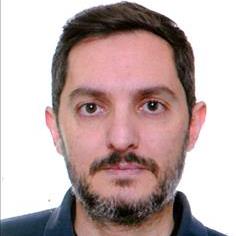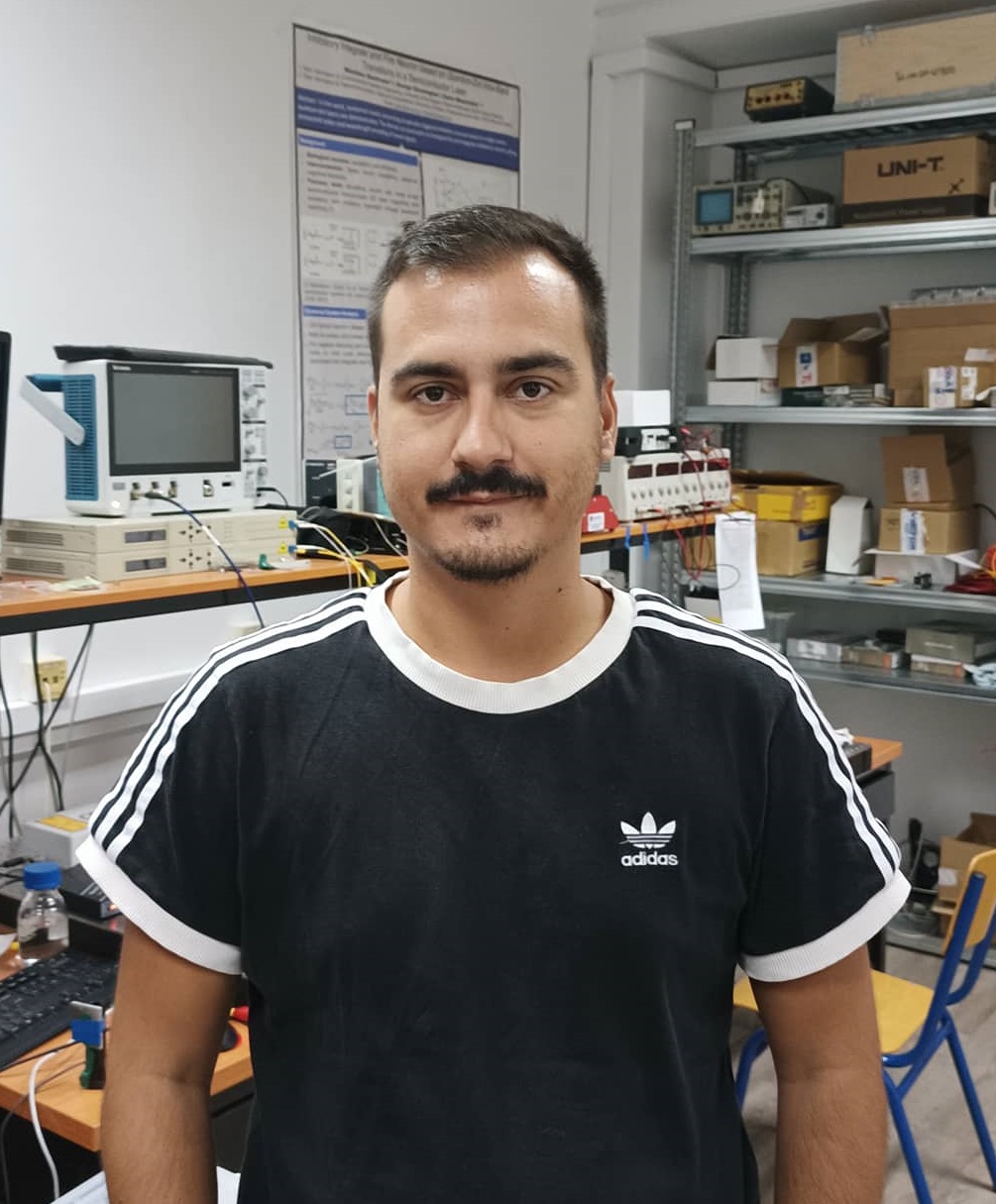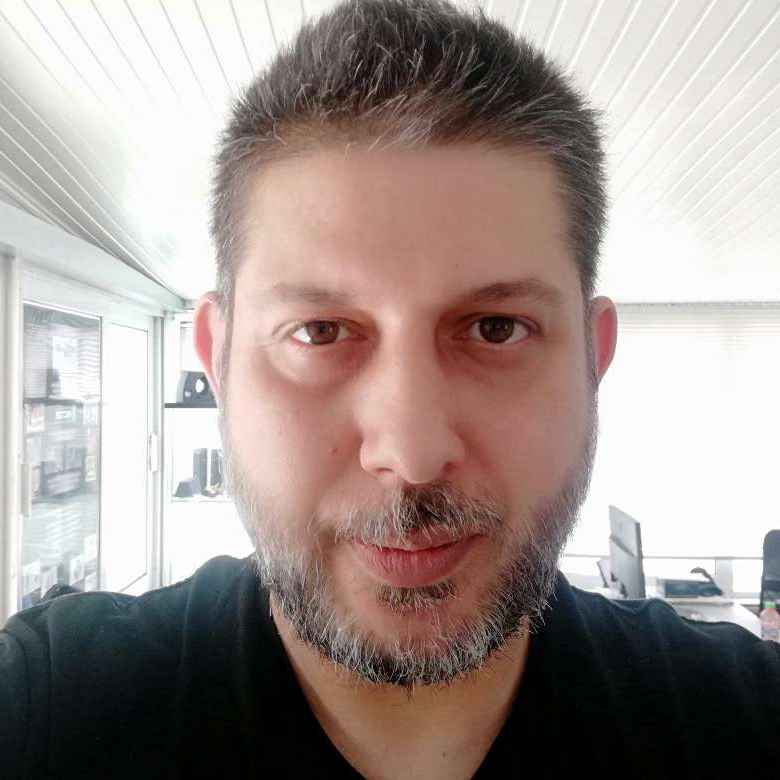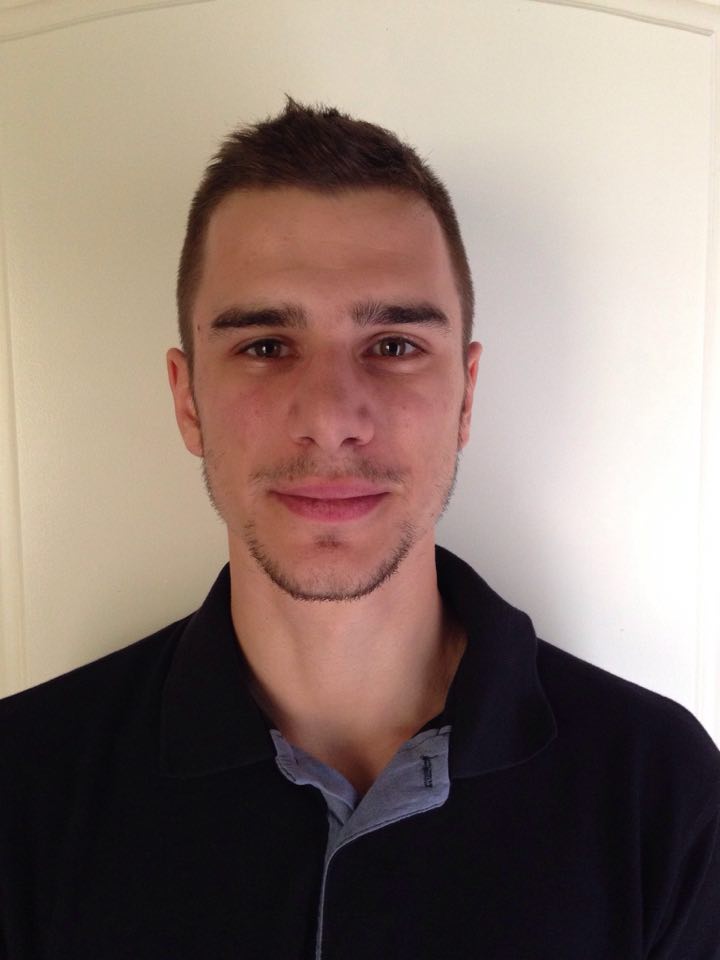RESEARCH UNIT ON NEUROMORPHIC COMPUTING AND PHOTONICS (RNCP)
REASEARCH ACTIVITIES
Photonic neuromorphic computing is a rapidly evolving scientific field which attracts the interest worldwide due to its intrinsic scientific value and the niche applications it can enable. Bio-inspired computing can be performed in photonics with the use of pulsed lasers and complex waveguide structures achieving neuron-like behavior in unprecedented speeds and low consumption. The intrinsic parallelism of photonic circuits paves the wave for enhanced connectivity and scalability so as to solve complex problems at the speed of photons. RNCP members have a strong activity in the area as can be found in the publication record and in the participation in EU and national R&D projects.
Optical communication systems suffer from linear and nonlinear effects of the optical channel. Although modern ASICs can handle linear effects such as polarization mode dispersion and chromatic dispersion, the major limitation regarding the maximum capacity that can be achieved comes from the nonlinearities attributed to Kerr effect. RCNP investigates state of the art recursive neural networks and reservoir computing techniques so as to mitigate the nonlinear effects in long-haul WDM transmission systems. The same activity seeks for applying low complexity machine learning algorithms in short-area networks where consumption matters.

One of the key areas that MCP has invested is the envision-design and development of cryptographic devices based on electronic-photonics hardware for cyber-physical applications. In particular MCP has developed multiple designs of optical modules as non-replicable authentication tokens and secure pseudo-random generators able to be integrated in IoT ecosystems and solidifying their resilience against cyber-physical attacks. More importantly MCP is working towards combining its solid background on neuromoprhic engineering and crypto-systems, so as to spawn a new generation of electronic-photonic neuro-cryptographic devices able to offer a twofold advantage. On one hand, provide solid security features, such as data encryption and authentication, based on physical properties and secondly employ the same modules for anomaly detection and edge machine learning
The use of fiber infrastructures for environmental sensing is attracting global interest due to the fact that optical fibers emerge as low cost and easily accessible platforms exhibiting a large terrestrial deployment. Moreover, optical fiber networks offer the unique advantage of providing observations of submarine areas, where the sparse existence of permanent seismic instrumentation due to cost and difficulties in deployment limits the availability of high-resolution subsea information on natural hazards in both time and space. The use of optical techniques that leverage pre-existing fiber infrastructure can efficiently provide higher resolution coverage and pave the way for the identification of the detailed structure of the Earth especially on seismogenic submarine faults. RNCP and co-workers from other institutions has developed a new fibre-optics sensing technique relying microwave frequency fibre interferometry (MFFI) which is a simple and low-cost proposition compared to the state-of-the-art solutions exploiting distributed acoustic sensing. The technique has been published in Nature Scientific Reports (https://www.nature.com/articles/s41598-022-18130-x) and attracts the interest of many geophysicists and seismologists around the globe.

RNCP PROJECTS
RNCP PEOPLE
RNCP Unit Directors
RNCP Researchers – PhD Students
RNCP PUBLICATIONS
Publications in international scientific journals
- Sarantoglou, G., Bogris, A., & Mesaritakis, C. (2024). All-Optical, Reconfigurable and Power Independent Neural Activation Function by Means of Phase Modulation. arXiv preprint arXiv:2402.03778.
- Dermanis, D., Rizomiliotis, P., Bogris, A., & Mesaritakis, C. (2024). Pseudo-Random Generator based on a Photonic Neuromorphic Physical Unclonable Function. arXiv preprint arXiv:2402.14876.
- Sozos, K., Da Ros, F., Yankov, M. P., Sarantoglou, G., Deligiannidis, S., Mesaritakis, C., & Bogris, A. (2024). Experimental Investigation of a Recurrent Optical Spectrum Slicing Receiver for Intensity Modulation/Direct Detection systems using Programmable Photonics. arXiv preprint arXiv:2406.16869.
- Tsilikas, I., Tsirigotis, A., Sarantoglou, G., Deligiannidis, S., Bogris, A., Posch, C., … & Mesaritakis, C. (2024). Photonic Neuromorphic Accelerators for Event-Based Imaging Flow Cytometry. arXiv preprint arXiv:2404.10564.
- Tsirigotis, A., Sarantoglou, G., Deligiannidis, S., Sanchez, E., Gutierrez, A., Bogris, A., … & Mesaritakis, C. (2024). Photonic Neuromorphic Accelerator for Convolutional Neural Networks based on an Integrated Reconfigurable Mesh. arXiv preprint arXiv:2405.06434.
- Sozos, K., Deligiannidis, S., Mesaritakis, C., & Bogris, A. (2024). Unconventional Computing based on Four Wave Mixing in Highly Nonlinear Waveguides. IEEE Journal of Quantum Electronics.
- S. Deligiannidis, K. R. H. Bottrill, K. Sozos, C. Mesaritakis, P. Petropoulos and A. Bogris, “Multichannel Nonlinear Equalization in Coherent WDM Systems based on Bi-directional Recurrent Neural Networks,” in Journal of Lightwave Technology, doi: 10.1109/JLT.2023.3318559.
- Tsirigotis, G. Sarantoglou, S. Deligiannidis, K. Sozos, C. Mesaritakis, “Integrated Photonic Accelerator Based on Optical Spectrum Slicing for Convolutional Neural Networks”, arxiv.org:2303.10357 (2023)
- Sozos, S. Deligiannidis, C. Mesaritakis, A. Bogris. “Self-Coherent Receiver Based on a Recurrent Optical Spectrum Slicing Neuromorphic Accelerator” IEEE Journal of Lightwave Technology, 41, 2666-2674 (2023)
- Skontranis, M., Sarantoglou, G., Sozos, K., Kamalakis, T., Mesaritakis, C., & Bogris, A. (2023). Multimode fabry-perot laser as a reservoir computing and extreme learning machine photonic accelerator. Neuromorphic Computing and Engineering, 3(4), 044003.
- K. Sozos, S. Deligiannidis, G. Sarantoglou, C. Mesaritakis and A. Bogris, “Recurrent Neural Networks and Recurrent Optical Spectrum Slicers as Equalizers in High Symbol Rate Optical Transmission Systems,” in Journal of Lightwave Technology, vol. 41, no. 15, pp. 5037-5050, 1 Aug.1, 2023, doi: 10.1109/JLT.2023.3282999.
- Tsirigotis, G. Sarantoglou, M. Skontranis, S. Deligiannidis, K. Sozos, G. Tsilikas, D. Dermanis, A. Bogris, C. Mesaritakis. “Unconventional Integrated Photonic Accelerators for High-Speed Convolutional Neural Networks”. (invited) Science, Intelligence Computing, 2023:0032. DOI:10.34133/icomputing.0032
- Lentas, K., Bowden, D., Melis, N. S., Fichtner, A., Koroni, M., Smolinski, K., … & Simos, I. (2023). Earthquake location based on Distributed Acoustic Sensing (DAS) as a seismic array. Physics of the Earth and Planetary Interiors, 107109
- Sozos, A. Bogris, G. Sarantoglou, P. Bienstman, C. Mesaritakis, “High-Speed Photonic Neuromorphic Computing Using Recurrent Optical Spectrum Slicing Neural Networks” 1:(24) doi.org/10.1038/s44172-022-00024-5 Nature Communication Engineering, (2022)
- Bogris, T. Nikas, C. Simos, I. Simos, K. Lentas, Ν. S. Melis, A. Fichtner, D. Bowden, K. Smolinski, C. Mesaritakis & I. Chochliouros. “Sensitive seismic sensors based on microwave frequency fiber interferometry in commercially deployed cables”. Nature Scientific Reports 12, 14000 (2022)
- Bowden, D. C., Fichtner, A., Nikas, T., Bogris, A., Simos, C., Smolinski, K., … & Melis, N. S. (2022). Linking Distributed and Integrated Fiber‐Optic Sensing. Geophysical Research Letters, 49(16), e2022GL098727
- Fichtner, A., Bogris, A., Nikas, T., Bowden, D., Lentas, K., Melis, N. S., … & Smolinski, K. (2022). Theory of phase transmission fibre-optic deformation sensing. Geophysical Journal International, 231(2), 1031-1039
- Fichtner, A., Bogris, A., Bowden, D., Lentas, K., Melis, N. S., Nikas, T., … & Smolinski, K. (2022). Sensitivity kernels for transmission fibre optics. Geophysical Journal International, 231(2), 1040-1044.
- Sarantoglou, A. Bogris, C. Mesaritakis, S. Thodoridis, “Bayesian Photonic Accelarators for Energy Efficient and Noise Robust Neural Processing” (invited) IEEE Selected Topics in Quantum Electronics, 10.1109/JSTQE.2022.3183444 (2022)
- Dermanis, A. Bogris, P. Rizomiliotis, C. Mesaritakis, “Photonic Physical Unclonable Function based on an Integrated Neuromorphic schemes” IEEE Journal of Lightwave Technology 10.1109/JLT.2022.3200307 (2022)
- Skontranis, G. Sarantoglou, A. Bogris, C. Mesaritakis, “Time-Delayed Reservoir Computing Based on Dual-Waveband Quantum-Dot Spin-Polarized Vertical Cavity Surface-Emitting Laser” Optica Material Optics Express, 12(10), 4047-4060 (2022)
- Υ. Hong, S. Deligiannidis, N. Taengnoi, K. R. H. Bottrill, N. K. Thipparapu, Y. Wang, J. K. Sahu, David J. Richardson, C. Mesaritakis, A. Bogris, and P. Petropoulos, “ML-assisted Equalization for 50-Gb/s/λ O-band CWDM Transmission over 100-km SMF” IEEE Selected Topics in Quantum Electronics1109/JSTQE.2022.3155990 (2022).
- Sarantoglou, M. Skontranis, A. Bogris, C. Mesaritakis, “Experimental study of Neuromorphic Node based on a Multi- Waveband Emitting two – section Quantum Dot Laser” OSA Photonic Research, Vol. 9, No. 4 pp. B87 doi: 10.1364/PRJ.413371 (2021)
- Skontranis, G. Sarantoglou, S. Deligiannidis, A. Bogris, C. Mesaritakis, “Unsupervised Image Classification Through Time-Multiplexed Photonic Multi-Layer Spiking Convolutional Neural Network” Appl. Sci. 2021, 11(4) (2021)
- Sozos, C. Mesaritakis, A. Bogris “Monolithic Integrated Optoelectronic Reservoir Computing Processor based on Mutually Injected Phase Modulated Semiconductor Lasers” IEEE Selected Topics in Quantum Electronics accepted for publication (2021)
- S. Deligiannidis, C. Mesaritakis, A. Bogris, “Performance and Complexity Analysis of i-directional Recurrent Neural Network Models vs. Volterra Nonlinear Equalizers in Digital Coherent Systems”, ΙΕΕΕ Journal of Lightwave Technology , Vol.39, No.18 pp. 5791 (2021)
- M. Skontranis, G. Sarantoglou, S. Deligiannidis, A. Bogris, C. Mesaritakis, “Time-Multiplexed Spiking Convolutional Neural Network based on VCSELs for Unsupervised Image Classification”, Applied Sciences, accepted for publication (2021)
- G. Sarantoglou, M. Skontranis, A. Bogris, C. Mesaritakis, “Experimental study of Neuromorphic Node based on a Multi- Waveband Emitting two – section Quantum Dot Laser” OSA Photonic Research, doi: 10.1364/PRJ.413371 (2021)
- M. Skontranis, G. Sarantoglou, S. Deligiannidis, A. Bogris, C. Mesaritakis, “Unsupervised Image Classification Through Time-Multiplexed Photonic Multi-Layer Spiking Convolutional Neural Network” MDPI Applied Sciences, special issue on Optical Computing, accepted for publication (2021)
- Bogris, C. Mesaritakis, Stavros Deligiannidis, Pu Li “All Optical Integrate and Fire Neuromorphic Node based on Single Section Quantum Dot Laser” IEEE Selected Topics in Quantum Electronics, Volume: 27, Issue: 2, (2020)
- Mesaritakis, P. Rizomiliotis, M. Akriotou, C. Chaintoutis, A. Fragkos, D. Syvridis “Photonic Pseudo-Random Number Generator for Internet-of-Things Authentication using a Waveguide based Physical Unclonable Function” Arxiv.org (2020)
- Deligiannidis, A. Bogris, C. Mesaritakis, Y. Kopsinis, “Compensation of Fiber Nonlinearities in Digital Coherent Systems Leveraging Long Short-Term Memory Neural Networks” ΙΕΕΕ Journal of Lightwave Technology Volume: 38, Issue: 21, pp. 5991-5999 (2020)
- Sarantoglou, M. Skontranis, C. Mesaritakis, “All Optical Integrate and Fire Neuromorphic Node based on Single Section Quantum Dot Laser” IEEE Selected Topics in Quantum Electronics, accepted for publication (2019)
Conference Proceedings
- A. Bogris, K. Sozos, G. Sarantoglou, S. Deligiannidis and C. Mesaritakis, “Neuromorphic computing by means of recurrent spectrum slicing for next generation high baud rate transmission systems,” 2023 IEEE Photonics Society Summer Topicals Meeting Series (SUM), Sicily, Italy, 2023, pp. 1-2, doi: 10.1109/SUM57928.2023.10224454.
- K. Sozos, S. Deligiannidis, C. Mesaritakis and A. Bogris, “Unconventional Computing based on Four Wave Mixing in Highly Nonlinear Media,” 2023 Conference on Lasers and Electro-Optics Europe & European Quantum Electronics Conference (CLEO/Europe-EQEC), Munich, Germany, 2023, pp. 1-1, doi: 10.1109/CLEO/Europe-EQEC57999.2023.10231929.
- S. Deligiannidis et al., “Deep-Learning-Based VCSEL Transmitter Emulator,” 2023 Conference on Lasers and Electro-Optics Europe & European Quantum Electronics Conference (CLEO/Europe-EQEC), Munich, Germany, 2023, pp. 1-1, doi: 10.1109/CLEO/Europe-EQEC57999.2023.10232151.
I. Tsilikas, A. Tsirigotis, S. Deligiannidis, G. N. Tsigaridas, A. Bogris and C. Mesaritakis, “Time-Stretched Imaging Flow Cytometry and Photonic Neuromorphic Processing for Particle Classification,” 2023 Conference on Lasers and Electro-Optics Europe & European Quantum Electronics Conference (CLEO/Europe-EQEC), Munich, Germany, 2023, pp. 1-1, doi: 10.1109/CLEO/Europe-EQEC57999.2023.10232590.
I. Tsilikas, S. Deligiannidis, A. Tsirigotis, G. N. Tsigaridas, A. Bogris and C. Mesaritakis, “Neuromorphic Camera Assisted High-Flow Imaging Cytometry for Particle Classification,” 2023 Conference on Lasers and Electro-Optics Europe & European Quantum Electronics Conference (CLEO/Europe-EQEC), Munich, Germany, 2023, pp. 1-1, doi: 10.1109/CLEO/Europe-EQEC57999.2023.10232061.
A. Tsirigotis, I. Tsilikas, K. Sozos, A. Bogris and C. Mesaritakis, “Photonic Neuromorphic Accelerator Combined with an Event-Based Neuromorphic Camera for High-Speed Object Classification,” 2023 Conference on Lasers and Electro-Optics Europe & European Quantum Electronics Conference (CLEO/Europe-EQEC), Munich, Germany, 2023, pp. 1-1, doi: 10.1109/CLEO/Europe-EQEC57999.2023.10232077.
- Smolinski, K. T., Bowden, D. C., Lentas, K., Melis, N. S., Simos, C., Bogris, A., … & Fichtner, A. (2022, December). Exploring DAS as a Tool for Earthquake Monitoring in Urban Environments. In AGU Fall Meeting Abstracts (Vol. 2022, pp. S12E-0190).
- Bogris, A., Nikas, T., Simos, C., Simos, I., Lentas, K., Melis, N. S., … & Mesaritakis, C. (2022, December). Microwave Frequency Fiber Interferometry (MFFI): A Promising Technique for Earthquake detection in Commercially Deployed Cables. In AGU Fall Meeting Abstracts (Vol. 2022, pp. S16A-01).
- C. Mesaritakis, G. Sarantoglou, A. Bogris “Bayesian Training in Reconfigurable Photonic Neuromorphic Meshes”, (invited) IEEE Workshop on Complexity in Engineering (COMPENG), Florence-Italy (2022)
- Bowden, D., Fichtner, A., Nikas, T., Bogris, A., Lentas, K., Simos, C., … & Melis, N. (2022, May). Comparing two fiber-optic sensing systems: Distributed Acoustic Sensing and Direct Transmission. In EGU General Assembly Conference Abstracts (pp. EGU22-11599).
- M. Skontranis, G. Sarantoglou, A. Bogris, C. Mesaritakis “Spectro-temporally Multiplexed Reservoir Computing Based on a Multimode Fabry Perot Laser” ECOC Basel – Switzerland 2022
- Smolinski, K. T., Bowden, D. C., Lentas, K., Melis, N. S., Simos, C., Bogris, A., … & Fichtner, A. (2022, May). Distributed Acoustic Sensing in the Athens Metropolitan Area: Preliminary Results. In EGU General Assembly Conference Abstracts (pp. EGU22-11864)
- A. Bogris, K Sozos, S. Deligiannidis, G. Sarantoglou, C. Mesaritakis, “Machine Learning and Neuromorphic Computing Approaches for the mitigation of transmission impairments in high baud rate transmission systems,” ECOC 2022 (Invited)
- A. Tsirigotis, I. Tsilikas, K. Sozos, A. Bogris, C. Mesaritakis “Filter-Based Photonic Reservoir Computing as a key-enabling platform for all-optical high-speed processing of time-stretched images and telecomm data” (invited) SPIE Photonics West, AI and Optical Data Sciences III, San Francisco USA 24-26 February 2022.
- A. Bogris, C. Simos, I. Simos, T. Nikas, N. Melis, K. Lentas. C. Mesaritakis, I. Chochliouros, C. Lessi, ” Microwave frequency dissemination systems as sensitive and low-cost interferometers for earthquake detection on commercially deployed fiber cables”, OFC 2022, San Francisco USA
- G. Sarantoglou, K. Sozos, T. Kamalakis, C. Mesaritakis, A. Bogris, “Experimental demonstration of an extreme learning machine based on Fabry Perot lasers for parallel neuromorphic processing” OFC 2022, San Francisco USA
- K. Sozos, A. Bogris, P. Bienstman, C. Mesaritakis, “Photonic Reservoir Computing based on Optical Filters in a Loop as a High Performance and Low-Power Consumption Equalizer for 100 Gbaud Direct Detection Systems” ECOC, Bordeaux France 2021
- A. Bogris, K. Sozos, A. Tsirigotis, C. Mesaritakis, “Neuromorphic Integrated Photonics as Hardware Accelerators for Ultra-high Speed Telecom and Imaging Applications” Photonics in Switching and Computing, OSA Virtual Conference (invited) (2021)
- M. Skontranis, G. Sarantoglou, A. Bogris, C. Mesaritakis, “Photonic Spiking Convolutional Neural Networks for High-Speed Image Processing” (Invited) IEEE Summer Topical Meetings 2021 19- 21 July Virtual Conference (2021)
- C. Mesaritakis, K. Sozos, D. Dermanis, A. Bogris, “Spatial Photonic Reservoir Computing based on Non-Linear Phase-to-Amplitude Conversion in Micro-Ring Resonators” OFC USA 2021
- K. Sozos, C. Mesaritakis, A. Bogris, “Reservoir Computing based on Mutually Injected Phase Modulated Lasers: A monolithic integration approach suitable for short-reach communication systems”, OFC USA 2021
- Y. Hong; S. Deligiannidis; N. Taengnoi; K. Bottrill; N. Thipparapu; Y. Wang; J. Sahu; D. Richardson; C. Mesaritakis; A. Bogris; P. Petropoulos, «Performance-enhanced Amplified O-band WDM
Transmission using Machine Learning based Equalization» CLEO San Hose-USA (2021), - G. Sarantoglou, M. Skontranis,A. Bogris, C. Mesaritakis, “Resonate and Fire Neuromorphic Node based on two – section Quantum Dot Laser with multi-waveband dynamics”, ECOC-CLEO– Brussels, December (2020)
- M. Skontranis, G. Sarantoglou, S. Deligiannidis, A. Bogris, C. Mesaritakis,”Unsupervised Image Classification Through Time-Multiplexed Photonic Multi-Layer Spiking Convolutional Neural Network”, ECOC-CLEO– Brussels, December (2020)
- S. Deligiannidis, C. Mesaritakis, A. Bogris, “Performance and Complexity Evaluation of Recurrent Neural Network Models for Fibre Nonlinear Equalization in Digital Coherent Systems”, ECOC – Brussels, December (2020)
- Mesaritakis, M. Skontranis, G. Sarantoglou, A. Bogris, “Micro-Ring-Resonator Based Passive Photonic Spike-Time- Dependent-Plasticity Scheme for Unsupervised Learning in Optical Neural Networks” OFC USA – San Diego, March (2020)
- Sarantoglou, M. Skontranis, A. Bogris, C. Mesaritakis, “Temporal Resolution Enhancement in Quantum-Dot Laser Neurons due to Ground State Quenching Effects” OFC USA – San Diego, March (2020)
- A. Bogris “Multi-mode lasers as potential machines for reservoir computing of enhanced power” ERC International Workshop – Invited – Photonic Reservoir Computing and Information Processing in Complex Networks, Trento-Italy (2019)
- Mesaritakis “Passive Photonic Components as Building Blocks for Ultra-Fast Reservoir Computing and as Photonic Spike Dependent Plasticity Enabling Structures” ERC International Workshop – Invited – Photonic Reservoir Computing and Information Processing in Complex Networks, Trento-Italy (2019)
- Mesaritakis, “Photonic Reservoir Computing based on the Random-Interaction of Transverse Optical Modes in Large-Cross Section Waveguides” CLEO/EQEC Europe, Munich-Germany (2019)
- Μ. Skontranis, G. Sarantoglou, C. Mesaritakis, “Inhibitory Integrate and Fire Neuron based on Quantum-Dot Intra-Band Transitions in a Semiconductor Laser” CLEO/EQEC Europe, Munich-Germany (2019)
- Μ. Skontranis, G. Sarantoglou, C. Mesaritakis, “All-optical Inhibitory Integrate and Fire Neuron based on a Single-Section Quantum-Dot Semiconductor Laser” CLEO USA, San-Diego California USA (2019)
RNCP NEWS
Mimicking the brain (live)
Mimicking the brain (live)
A special live show brought to you from the Berlin Science Week 2022. A recent study in Communications Engineering presents a photonic setup to create a neural network. Tune in to find out more…
Featuring Charis Mesaritakis (University of the Aegean) and Miranda Vinay (Communications Engineering)
Hosted by Cristiano Matricardi (Nature Communications)
Ref: Sozos, K., Bogris, A., Bienstman, P. et al. High-speed photonic neuromorphic computing using recurrent optical spectrum slicing neural networks. Commun Eng 1, 24 (2022). https://doi.org/10.1038/s44172-022-00024-5
ON YOUR WAVELENGTH – ADONIS BOGRIS, CHARIS MESARITAKIS
On your wavelength is a (physics) podcast where we discuss a paper published recently in a Nature Portfolio journal. We invite the author(s) and the editor of the paper for an interview, and explore the story behind the paper, including the conception of the research and aspects that you do not find written in the publication — essentially, an account of the ‘scientific journey’ of the paper until completion. We also go through the editorial process with the editor to give a different point of view and discuss post-publication content (if any) and future outlooks.
During this episode, we will talk about neuromorphic computing, which can be interpreted as biologically inspired computing facilitated by deep learning algorithms. The paper we will discuss brings the implementation of this new way of computing one step closer to real-world devices. The authors use light and a clever filtering system that could allow high-bandwidth communications and high-speed imaging.
Authors: Adonis Bogris, University of West Attica, Greece & Charis Mesaritakis, University of the Aegean, Greece
Editor: Miranda Vinay, Communications Engineering
Host: Cristiano Matricardi, Nature Communications
Follow RNCP On Social Media
RNCP
Ag. Spyridonos, 122 43 Egaleo,
Attica, Greece
email: Adonis Bogris: abogris@uniwa.gr || Charis Mesaritakis: cmesar@aegean.gr
web: rncp.eu

























